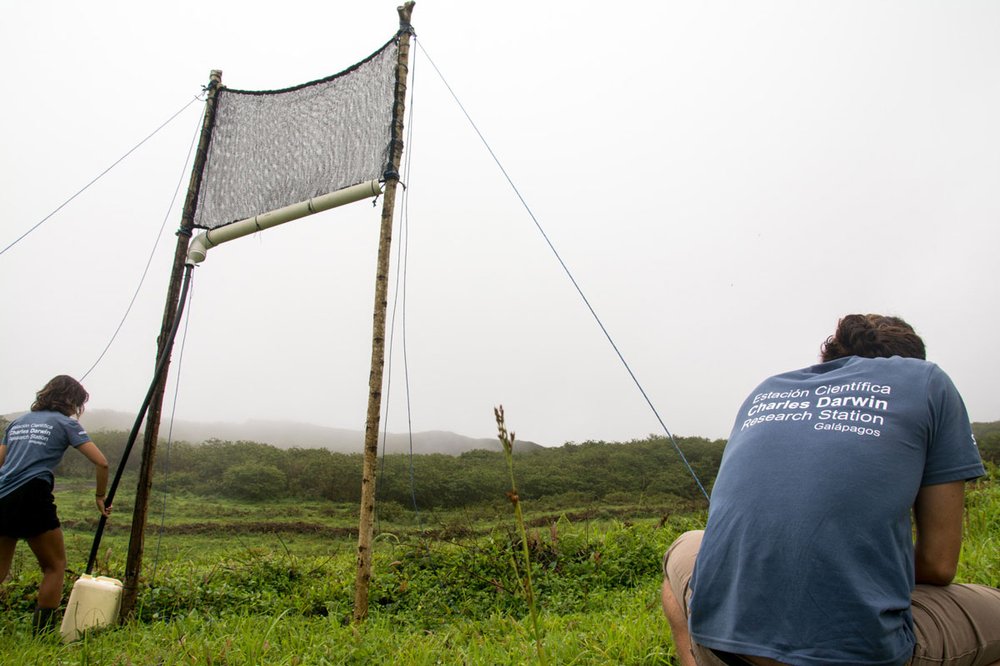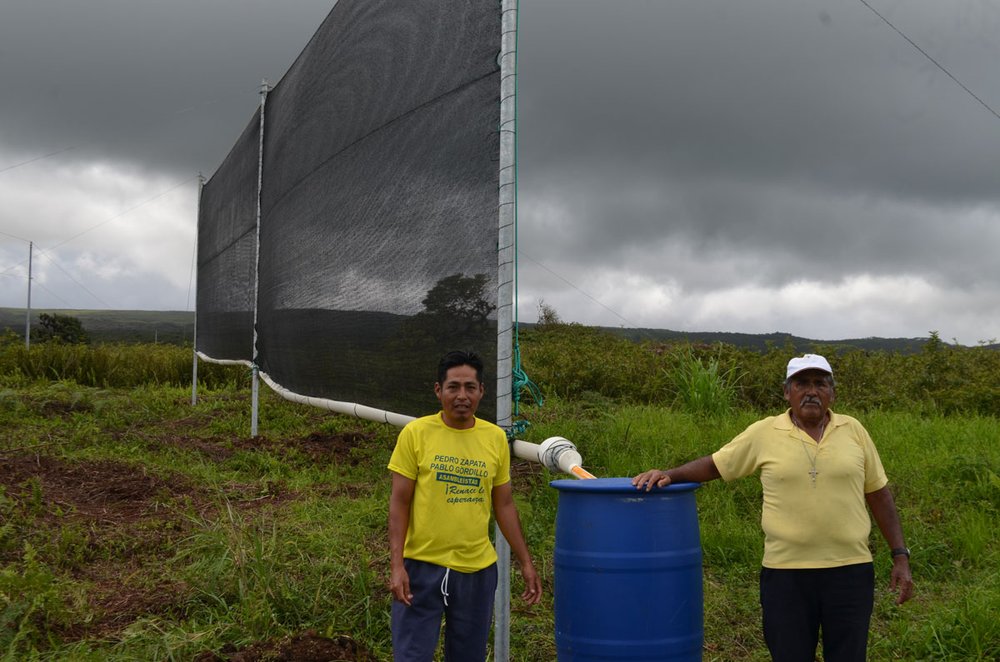Author: Ernesto Bustamante, former CDF staff member
At the end of October 2021, marked one year since the first fog catcher systems of the “Harvesting Water” Project were installed. The purpose of this initiative was to increase the amount of available fresh water, by means of encouraging sustainable livestock and agriculture on the island. In this way it contributes to the production of healthy food and the reduction of dependence on food from Santa Cruz and mainland Ecuador.

These systems have been installed in different parts of the world. In Latin America it is common to find them in Chile, Peru and Colombia. In Ecuador these have been also implemented in the provinces of Loja, Chimborazo and Pichincha (Gov. Pichincha, 2015). The Fog Catchers consist of one or more 40 to 50m2 frame structures that supports a “rachel” or “polisombra 65/35” mesh. As the mist passes through the mesh, it condenses into water droplets that fall into a 6” diameter PVC pipe. This collecting tube ends in a 200-liter collecting tank that stores and distributes the collected water.
“The fog catchers are a very important tool to promote livestock and agricultural production in Isabela. These systems give us the opportunity to continue working on obtaining and managing water which is vital for the agricultural production in our island”. Eng. Romni Rodríguez, Agricultural Technician of the Ministry of Agriculture in Isabela.
At “Harvesting Water” we installed three 80m2 fog catchers in different locations in the highlands of Isabela. For this purpose, twelve sample tests were carried out at different locations that met the appropriate terrain features for the installation of fog trap systems according to the “FogQuest Fog Water Collection Manual” (2017 Edition). These characteristics include; an altitude higher than 400 meters above sea level, moderate gentle slopes, clear areas, and constant light or moderate wind.
In each of these locations, mini fog catchers or prototype fog catchers were installed, which are a 1/80 scale replica of the fog catcher systems. This means, they have a 1m2 frame. These prototypes were placed for an average time of two weeks, in order to be able to know the mist water collection potential at each location. The sampling tests were carried out between December 2019 and July 2020. The three places that had the best results and that met the selection criteria established by the project were selected.

The first fog catcher was installed in October 2020, at the control site of the the Galapagos National Park Directorate (GNPD) in the “El Cura” sector. The collected water is used by the park rangers engaged in the control and tourist facilities of the Sierra Negra volcano. In the same month, a second fog catcher was installed in the “Raquelita” farm owned by Mr. Juan Tupiza in the “Los Mellizos” sector. The third one was installed in March 2021 at the “La Florida” farm owned by Mr. Carlos Jaramillo in the “El Cura” sector. Both livestock farms are using the collected water for their cattle and to start agricultural activities.
As part of the commitments made by the beneficiaries with the project, they must carry out daily monitoring of the amount of water collected by their 80m2 fog catchers. For this, the data collection is conducted every day on 1m2 prototype Fog Catchers installed next to the large systems. The collected water of these mini Fog Catcher is transported and deposited in a 20-liter gallon. This allows to estimate up to 1.600 liters / day due to the water collected by the 1m2 mini fog traps is being multiplied by 80 - to estimate the amount collected by the 80m2 systems.
“We are using the collected water for our cows and we are also clearing a field to start planting corn, green and banana. The water helps me with the cattle, I have greatly reduced the need to bring water with tankers” Mr. Juan Tupiza, beneficiary of the project.

The first year of monitoring shows that the highest average amount of water per moth collected were in the peak months of the “wet” season (Garua season), that is, between July and September. The least average amount of water collected per month were April and May, which are months of transition from the "dry" to the "wet" season. The daily average water collected in the 3 systems installed was 239,3 liters/day - 7.179 liters/month. Also, the systems with higher altitudes are those with better results. In August 2021, the highest average water collection was obtained with 1.326,67 liters/day - 39.800,1 liters/month in the fog catcher located at the control site of the GNPD (highest locality with 899 meters above sea level). In April 2021, the lowest average was obtained with 31.74 liters/day - 952 liters/month in the fog catcher on the “La Florida” farm of the Jaramillo family (lowest locality with 636 meters above sea level).
The results allow us to observe trends in the behavior of the mist and in the amount of water collected in the selected farms. In general, a significant potential for mist water collection in certain areas of the upper part of Isabela has been demonstrated. Therefore, Fog Catcher systems are a real option in Isabela, should be explored on other islands as a technology - simple to implement, easy to maintain, cost effective and friendly to the environment that can contribute to the strengthening of agricultural production in the islands.
“Sustainable initiatives are welcome in the conservation of the Galapagos ecosystems and in particular if they are adjusted to the management of protected areas, as is the case of the location of fog catchers at the El Cura control site in the Sierra Negra Volcano. Has helped us to improve our capacity to collect water to be used in our facilities. These systems should continue to be implemented in agricultural areas to help their beneficiaries in their productive activities”. Head of the Environmental Education and Social Participation Area of the Isabela Technical Unit of the GNPD.






